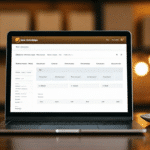How to Set Up Custom Shipping Rates for Your Business
Online businesses today face a multitude of challenges when it comes to shipping logistics. Shipping can make or break customer satisfaction, which in turn affects your bottom line. Offering custom shipping rates can be a game-changer for your online business. In this article, we'll explore the importance of custom shipping rates, different types of shipping rates, factors to consider when setting them up, analyzing shipping data, negotiating better rates, common mistakes to avoid, testing and fine-tuning rates, and integrating with your e-commerce platform. By the end of this article, you'll be equipped with the knowledge to set up custom shipping rates for your business and ensure customer satisfaction.
Why Custom Shipping Rates are Important for Your Business
Custom shipping rates are essential because they allow your business to take control of your shipping costs. Relying on standard shipping rates from carriers might seem easier, but it can quickly erode your profit margins. With custom shipping rates, you have the flexibility to set rates according to the specific needs of your business and customers. This adaptability provides a competitive advantage, enabling you to offer discounted rates for larger orders or specific products and premium shipping options for customers willing to pay more.
Another significant benefit of custom shipping rates is the ability to build customer loyalty. By offering personalized shipping options, you enhance the customer experience and increase satisfaction, leading to repeat business and positive word-of-mouth referrals. Additionally, custom shipping rates help optimize your shipping processes, reducing the risk of errors or delays. By setting specific rates for different products or shipping zones, you can streamline operations and ensure timely and cost-effective deliveries.
Understanding the Different Types of Shipping Rates
When setting up custom shipping rates, it's essential to understand the various types available:
- Flat-Rate Shipping: Charge a fixed amount for shipping regardless of the order's size or weight.
- Weight-Based Shipping: Charge customers based on the weight of the products and the destination.
- Price-Based Shipping: Charge customers based on the total price of the products and the destination.
- Carrier-Calculated Shipping: Use data from shipping carriers to determine the cost dynamically.
- Free Shipping: Offer shipping at no cost to the customer.
Each type of shipping rate has its advantages and disadvantages. For instance, flat-rate shipping is straightforward but may not be cost-effective for larger orders. Weight-based shipping is more accurate but can be complex to calculate. Price-based shipping is ideal for high-value items but may not suit low-priced products. Carrier-calculated shipping is precise and can save money but requires integration with a carrier's API. Free shipping is an excellent incentive but can impact profit margins if not managed correctly. The choice of shipping rates should align with your business's specific needs and goals.
Factors to Consider When Setting Up Custom Shipping Rates
Several factors must be considered when establishing custom shipping rates:
- Budget: Understand the maximum shipping costs for your products to set fair rates that cover expenses.
- Customer Needs: Consider customers' locations and shipping preferences, as these will influence the rates they are willing to pay.
- Preferred Carriers: Evaluate the services and rates offered by different carriers to determine the best fit for your business.
- Product Weight and Size: Heavier and larger items typically cost more to ship, necessitating rate adjustments.
- Shipping Distance and Delivery Time: Longer distances and expedited delivery options usually result in higher shipping costs.
Balancing competitive rates with covering your costs is crucial to ensure profitability while meeting customer expectations.
How to Analyze Your Shipping Data to Set Up Effective Rates
Analyzing your shipping data is critical to establishing effective custom shipping rates. Start by examining your previous orders, including locations, order details, and the shipping methods chosen by customers. This analysis will help you determine average order sizes, weights, delivery timeframes, and preferred shipping options.
Additionally, track the costs associated with shipping materials and labor. Understanding these expenses allows you to calculate the true cost of shipping each order and adjust your rates accordingly. Regularly reviewing and updating your shipping rates based on this data ensures that your rates remain competitive and profitable. Tools like shipping analytics platforms can aid in this process by providing detailed insights into your shipping operations.
Tips for Negotiating Better Shipping Rates with Carriers
Negotiating better shipping rates with carriers can significantly reduce your shipping costs. Here are some strategies:
- Compare Multiple Carriers: Obtain quotes from various carriers to benchmark pricing and services.
- Leverage Business Volume: Highlight the volume of orders you ship and your business's reliability to gain negotiating power.
- Clarify Your Needs: Clearly communicate the rates you seek and the services you require.
- Offer Long-Term Partnerships: Propose long-term contracts in exchange for more favorable rates.
- Consider Timing: Negotiate during off-peak seasons when carriers may have excess capacity and be more willing to offer discounts.
Building strong relationships with your carriers can lead to better terms and more reliable service, benefiting both your business and your customers.
Common Mistakes to Avoid When Setting Up Custom Shipping Rates
When establishing custom shipping rates, avoid these common mistakes:
- Undercharging or Overcharging: Setting rates too low can erode profits, while setting them too high can deter customers.
- Ignoring Surcharges: Failing to account for packaging materials or handling fees can lead to unexpected costs.
- Neglecting Regular Updates: Shipping rates and costs can fluctuate; failing to update your rates can make them outdated and uncompetitive.
- Limited Shipping Options: Offering only one shipping method can alienate customers with different needs and preferences.
- Lack of Transparency: Not clearly communicating shipping rates and options can confuse customers and lead to frustration.
By avoiding these pitfalls, you can maintain customer trust and ensure your shipping strategy supports your business's profitability.
How to Test and Fine-Tune Your Shipping Rates for Optimal Results
Testing and fine-tuning your shipping rates is essential to ensure they are effective and meet both your business and customer needs. Here’s how to approach this process:
- Monitor Order Volume and Feedback: Track how changes in shipping rates affect order volumes and listen to customer feedback to gauge satisfaction.
- Conduct A/B Testing: Offer different shipping rates to separate customer groups to determine which rates perform better in terms of conversion and satisfaction.
- Utilize Data Analytics: Employ analytics tools to monitor shipping costs, profit margins, and customer behavior related to shipping choices.
- Adjust Based on Destinations: Different regions may require different shipping rates based on distance and carrier costs.
- Stay Informed on Market Conditions: Keep abreast of changes in carrier rates and market trends to adjust your rates proactively.
Regularly refining your shipping rates based on testing and data analysis ensures that your rates remain competitive and aligned with your business goals.
Integrating Custom Shipping Rates into Your E-commerce Platform
Integrating custom shipping rates into your e-commerce platform streamlines your shipping process and reduces the likelihood of errors. Most e-commerce platforms, such as Shopify and BigCommerce, offer APIs, plugins, or extensions that facilitate custom shipping rate integrations. Ensure that your chosen platform is compatible with your preferred carriers to enable seamless rate calculations.
Additionally, providing a variety of shipping options, such as expedited or international shipping, enhances customer satisfaction and can boost sales. Real-time shipping quotes based on the customer's location and order details help reduce cart abandonment and increase conversions by offering transparency and flexibility in shipping choices.
Best Practices for Communicating Shipping Rates to Customers
Effective communication of shipping rates is crucial for maintaining transparency and building trust with your customers. Here are some best practices:
- Be Transparent: Clearly display shipping rates and any additional fees during the checkout process to avoid surprises.
- Provide Delivery Estimates: Offer estimated delivery timeframes so customers know when to expect their orders.
- Offer Multiple Shipping Options: Cater to different customer preferences by providing various shipping methods, such as standard, expedited, and international shipping.
- Update Customers on Changes: Inform customers promptly of any changes to shipping rates or policies to maintain trust.
- Provide Tracking Information: Offer tracking numbers and links to carrier websites so customers can monitor their orders.
- Highlight Free Shipping Offers: Promote free shipping on orders exceeding a certain amount to encourage larger purchases.
Clear and comprehensive communication regarding shipping rates and options enhances the overall customer experience and can positively impact your business's reputation and sales.
Conclusion
Setting up custom shipping rates for your business can significantly enhance your online operations and customer satisfaction. By considering factors such as budget, customer needs, and carrier services, and by avoiding common mistakes, you can establish a shipping strategy that supports your business's profitability and growth. Regularly analyzing shipping data, negotiating with carriers, and testing your rates will ensure that your shipping costs remain competitive and efficient. Effective integration with your e-commerce platform and transparent communication with customers further solidify a robust shipping framework. Implementing these best practices will empower your business to provide reliable and customer-friendly shipping solutions, driving success in the competitive online marketplace.




















